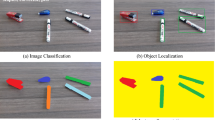Abstract
Displaying night-vision thermal images with day-time colors is paramount for scene interpretation and target tracking. In this paper, we employ object recognition methods for colorization, which amounts to segmenting thermal images into plants, buildings, sky, water, roads and others, then calculating colors to each class. The main thrust of our work is the introduction of Markov decision processes (MDP) to deal with the computational complexity of the colorization problem. MDP provides us with the approaches of neighborhood analysis and probabilistic classification which we exploit to efficiently solve chromatic estimation. We initially label the segments with a classifier, paving the way for the neighborhood analysis. We then update classification confidences of each class by MDP under the consideration of neighboring consistency and scenery layout. Finally we calculate the colors for every segment by blending the characteristic colors of each class it belongs to in a probabilistic way. Experimental results show that the colorized appearance of our algorithm is satisfactory and harmonious; the computational speed is quite fast as well.





Similar content being viewed by others
References
Carbonetto P, De Freitas N, Barnard K (2004) A statistical model for general contextual object recognition. Comput Vis ECCV. Springer, Berlin
Cheng Z, Yang Q, Sheng B(2015) Deep Colorization. The IEEE International Conference on Computer Vision (ICCV), pp 415–423
Farabet C, Couprie C, Najman L, Lecun Y (2012) Scene parsing with multiscale feature learning, purity trees, and optimal covers. arXiv preprint arXiv:1202.2160
Farabet C, Couprie C, Najman L, Lecun Y (2013) Learning hierarchical features for scene labeling. Pattern Anal Mach Intell IEEE Trans 35:1915–1929
Fernandes LA, Oliveira MM (2008) Real-time line detection through an improved Hough transform voting scheme. Pattern Recognit 41:299–314
Fulkerson B, Vedaldi A, Soatto S (2009) Class segmentation and object localization with superpixel neighborhoods. Comput Vis. IEEE 12th international conference on, 2009. IEEE, 670–677
Galleguillos C, Belongie S (2010) Context based object categorization: a critical survey. Comput Vis Image Underst 114:712–722
Gauge C, Sasi S (2011) Automated colorization of grayscale images using texture descriptors. ACEEE Int J Inf Technol 1(1):46–48
Gu X, Sun S, Fang JA, Zhou P (2012) Kernel based color estimation for night vision imagery. Optics Commun 285:1697–1703
He X, Zemel RS, Carreira-Perpindn M (2004) Multiscale conditional random fields for image labeling. Computer vision and pattern recognition, CVPR. Proceedings of the 2004 IEEE computer society conference, IEEE, 2:II-695–II-702
Hertzmann A, Jacobs CE, Oliver N, Curless B, Salesin DH (2001) Image analogies. Siggraph 2001 conference proceedings, 327–340
Hogervorst MA, Toet A (2010) Fast natural color mapping for night-time imagery. Inf Fusion 11:69–77
Hoiem D, Efros AA, Hebert M (2005) Geometric context from a single image. Comput Vis. IEEE 10th International Conference, IEEE, pp 654–661
Horiuchi T (2004) Colorization algorithm using probabilistic relaxation. Image Vis Comput 22:197–202
Hough PV (1959) Machine analysis of bubble chamber pictures. International conference on high energy accelerators and instrumentation
Irony R, Cohen-Or D, Lischinski D (2005) Colorization by example. Proceedings of the sixteenth eurographics conference on rendering techniques. Eurographics Association, 201–210
Kawulok M, Kawulok J, Smolka B (2011) Image colorization using discriminative textural features. MVA. Citeseer, pp 198–201
Kumar MS, Singh MD (2008) Colorization of gray image in \(\text{L}\alpha \beta \) color space using texture mapping and luminance mapping
Lafferty J, Mccallum A, Pereira FC (2001) Conditional random fields: probabilistic models for segmenting and labeling sequence data
Lee Y-S, Koo H-S, Jeong C-S (2006) A straight line detection using principal component analysis. Pattern Recognit Lett 27:1744–1754
Levin A, Lischinski D, Weiss Y (2004) Colorization using optimization. ACM Trans Gr TOG. ACM, 689–694
Luan Q, Wen F, Cohen- Or D, Liang L, Xu Y-Q, Shum H-Y (2007) Natural image colorization. Proceedings of the 18th Eurographics conference on rendering techniques. Eurographics Association, 309–320
Parikh D, Zitnick CL, Chen T (2008) From appearance to context-based recognition: Dense labeling in small images. Comput Vis Pattern Recognit CVPR. IEEE Conference, IEEE, 1–8
Reinhard E, Ashikhmin M, Gooch B, Shirley P (2001) Color transfer between images. IEEE Comput Gr Appl 21:34–41
Saxena A, Chung SH, Ng AY (2005) Learning depth from single monocular images. Adv Neural Inf Process Syst. 1161–1168
Saxena A, Sun M, Ng AY (2009) Make3d: learning 3d scene structure from a single still image. Pattern Anal Mach Intell IEEE Trans 31:824–840
Singhal A, Luo J (2003) Hybrid approach to classifying sky regions in natural images. Electron Imaging. International Society for Optics and Photonics, 562–572
Singhal A, Luo J, Zhu W (2003) Probabilistic spatial context models for scene content understanding. Comput Vis Pattern Recognit. Proceedings 2003 IEEE Computer Society Conference, IEEE. 1:I-235–I-241
Vailaya A, Jain AK (1999) Detecting sky and vegetation in outdoor images. Electron Imaging. International Society for Optics and Photonics, 411–420
Vedaldi A, Soatto S (2008) Quick shift and kernel methods for mode seeking. Comput Vis ECCV. Springer
Welsh T, Ashikhmin M, Mueller K (2002) Transferring color to greyscale images. Acm Trans Gr 21:277–280
Yatziv L, Sapiro G (2006) Fast image and video colorization using chrominance blending. Image Process IEEE Trans 15:1120–1129
Zhang Z, Cui H, Lu H, Chen R, Yan Y (2009) A colorization method based on fuzzy clustering and distance transformation. Image and signal processing. CISP’09. 2nd International Congress, IEEE, pp 1–5
Zhou P, Gu X, Zhang J, Fei M (2015) A priori trust inference with context aware stereotypical deep learning. Knowledge-Based Syst 88:97–106
Acknowledgments
The work was supported by National Natural Science Foundation of China under Grant No. 61205017, 61502293, 61573144, 61375007 and the Fundamental Research Funds for the Central Universities.
Author information
Authors and Affiliations
Corresponding author
Rights and permissions
About this article
Cite this article
Gu, X., He, M. & Gu, X. Thermal image colorization using Markov decision processes. Memetic Comp. 9, 15–22 (2017). https://doi.org/10.1007/s12293-016-0193-2
Received:
Accepted:
Published:
Issue Date:
DOI: https://doi.org/10.1007/s12293-016-0193-2




